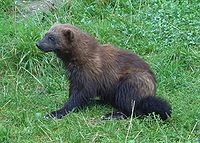
Mitochondrial haplogrouping of the ancient brown bears (Ursus arctos) in Bulgaria, revealed by the APLP method
Sign Up to like & getrecommendations! Published in 2020 at "Mammal Research"
DOI: 10.1007/s13364-020-00482-2
Abstract: In order to investigate the detailed zoogeographical history of brown bears (Ursus arctos) in Bulgaria and their relationships with populations in neighboring regions of Europe and Asia, the amplified product length polymorphism (APLP) method for… read more here.
Keywords: ursus arctos; bears ursus; aplp method; arctos bulgaria ... See more keywords

Analysis of hair steroid hormones in polar bears (Ursus maritimus) via liquid chromatography-tandem mass spectrometry: comparison with two immunoassays and application for longitudinal monitoring in zoos.
Sign Up to like & getrecommendations! Published in 2021 at "General and comparative endocrinology"
DOI: 10.1016/j.ygcen.2021.113837
Abstract: Analysis of hair cortisol concentrations (HCCs) is a promising method for monitoring long-term stress in mammals. However, previous measurements of HCCs in polar bears (Ursus maritimus) have yielded highly variable results, which are likely due… read more here.
Keywords: bears ursus; hair; analysis hair; hair steroid ... See more keywords

Cardiac adaptation in hibernating, free-ranging Scandinavian Brown Bears (Ursus arctos)
Sign Up to like & getrecommendations! Published in 2020 at "Scientific Reports"
DOI: 10.1038/s41598-019-57126-y
Abstract: During six months of annual hibernation, the brown bear undergoes unique physiological changes to adapt to decreased metabolic rate. We compared cardiac structural and functional measures of hibernating and active bears using comprehensive echocardiography. We… read more here.
Keywords: ursus arctos; bears ursus; free ranging; hibernation ... See more keywords

Natural rewilding of the Great Basin: Genetic consequences of recolonization by black bears (Ursus americanus)
Sign Up to like & getrecommendations! Published in 2018 at "Diversity and Distributions"
DOI: 10.1111/ddi.12666
Abstract: Aim In the mid-20th century, many populations of large-bodied mammals experienced declines throughout North America. Fortunately, within the last several decades, some have begun to rebound and even recolonize extirpated portions of their native range,… read more here.
Keywords: recolonized areas; recolonization; bears ursus; great basin ... See more keywords

Spring diet of American black bears (Ursus americanus) in a moose (Alces alces) – woodland caribou (Rangifer tarandus caribou) system in northern Ontario, Canada
Sign Up to like & getrecommendations! Published in 2021 at "Canadian Journal of Zoology"
DOI: 10.1139/cjz-2020-0263
Abstract: American black bears (Ursus americanus Pallas, 1780) are opportunistic foragers, and across most of their range in North America, their diet is predominantly vegetation with limited consumption of vertebrates and invertebrates. However, they are also… read more here.
Keywords: bears ursus; moose alces; ursus americanus; american black ... See more keywords

Do Wild Polar Bears (Ursus maritimus) Use Tools When Hunting Walruses (Odobenus rosmarus)?
Sign Up to like & getrecommendations! Published in 2021 at "Arctic"
DOI: 10.14430/arctic72532
Abstract: Since the late 1700s, reports of polar bears (Ursus maritimus) using tools (i.e., pieces of ice or stones) to kill walruses (Odobenus rosmarus) have been passed on verbally to explorers and naturalists by their Inuit… read more here.
Keywords: walruses odobenus; bears ursus; polar bears; ursus maritimus ... See more keywords

Do brown bears Ursus arctos avoid barbed wires deployed to obtain hair samples? A videographic assessment
Sign Up to like & getrecommendations! Published in 2020 at "Wildlife Biology"
DOI: 10.2981/wlb.00664
Abstract: Studies of the movements and abundance of predators can reveal their ecological roles and facilitate their conservation. These studies rely increasingly on noninvasive methods such as hair collection and camera traps. Insights from hair sampling,… read more here.
Keywords: hair samples; ursus arctos; bears ursus; hair ... See more keywords